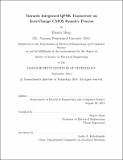| dc.contributor.advisor | Rajeev Ram. | en_US |
| dc.contributor.author | Meng, Huaiyu | en_US |
| dc.contributor.other | Massachusetts Institute of Technology. Department of Electrical Engineering and Computer Science. | en_US |
| dc.date.accessioned | 2015-02-05T15:58:47Z | |
| dc.date.available | 2015-02-05T15:58:47Z | |
| dc.date.copyright | 2014 | en_US |
| dc.date.issued | 2014 | en_US |
| dc.identifier.uri | http://hdl.handle.net/1721.1/93779 | |
| dc.description | Thesis: S.M., Massachusetts Institute of Technology, Department of Electrical Engineering and Computer Science, 2014. | en_US |
| dc.description | This electronic version was submitted by the student author. The certified thesis is available in the Institute Archives and Special Collections. | en_US |
| dc.description | Cataloged from student-submitted PDF version of thesis. | en_US |
| dc.description | Includes bibliographical references (pages 127-136). | en_US |
| dc.description.abstract | In recent years, the demand for Internet bandwidth increases while the unit price of bandwidth decreases. To keep up with the trend, more cost-eective optical telecommunication links are required. Due to the limited amount of optical fibers and wave- length range, increasing spectral eciency is a desirable approach. Advance modulation scheme, such as quadrature phase-shift keying (QPSK), is a possible solution. Another limitation is energy consumption. Power density within telecommunication data centers are regulated by law in consideration of ambient temperature and noise level. Therefore, optical transceivers with higher energy eciency is desired. Traditional transceivers use III-V chips for photonic components and CMOS chips for electronic circuits. Monolithic integration of photonic and electronic components helps removing energy consumption for inter-chip communication and hence increase overall energy eciency. In this thesis, a QPSK transceiver in zero-change CMOS process is proposed. Research is focused on three photonic components: 90 degree hybrids, poly-silicon photodetectors and QPSK modulators. Hybrids are used to mix QPSK-modulated signal and local oscillators with four equally-spaced phase delays. Multi-mode interferometers (MMI) are designed for this purpose. Best devices provides intensity imbalance around 1 dB and phase error around 10. For poly-silicon photodetectors, sub-bandgap defect states are used for electron-hole pair generation. A ring-resonant structure is used to enhance absorption and reduce footprint. Best devices have quantum eciency around 3.5% and dark current less than 60 nA under 25V reverse bias. The 3 dB frequency is around 1.2 GHz. Finally, double-coupled ring resonators with feed through waveguides are used for QPSK modulators. Carrier injection changes the resonance condition and provides phase shift. With the development of these devices, the path towards a monolithic QPSK transceiver in CMOS becomes clear. | en_US |
| dc.description.statementofresponsibility | by Huaiyu Meng. | en_US |
| dc.format.extent | 136 pages | en_US |
| dc.language.iso | eng | en_US |
| dc.publisher | Massachusetts Institute of Technology | en_US |
| dc.rights | M.I.T. theses are protected by copyright. They may be viewed from this source for any purpose, but reproduction or distribution in any format is prohibited without written permission. See provided URL for inquiries about permission. | en_US |
| dc.rights.uri | http://dspace.mit.edu/handle/1721.1/7582 | en_US |
| dc.subject | Electrical Engineering and Computer Science. | en_US |
| dc.title | Towards integrated QPSK transceiver on zero-change CMOS foundry process | en_US |
| dc.title.alternative | Towards integrated quadrature phase-shift keying transceiver on zero-change CMOS foundry process | en_US |
| dc.type | Thesis | en_US |
| dc.description.degree | S.M. | en_US |
| dc.contributor.department | Massachusetts Institute of Technology. Department of Electrical Engineering and Computer Science | |
| dc.identifier.oclc | 900733122 | en_US |
